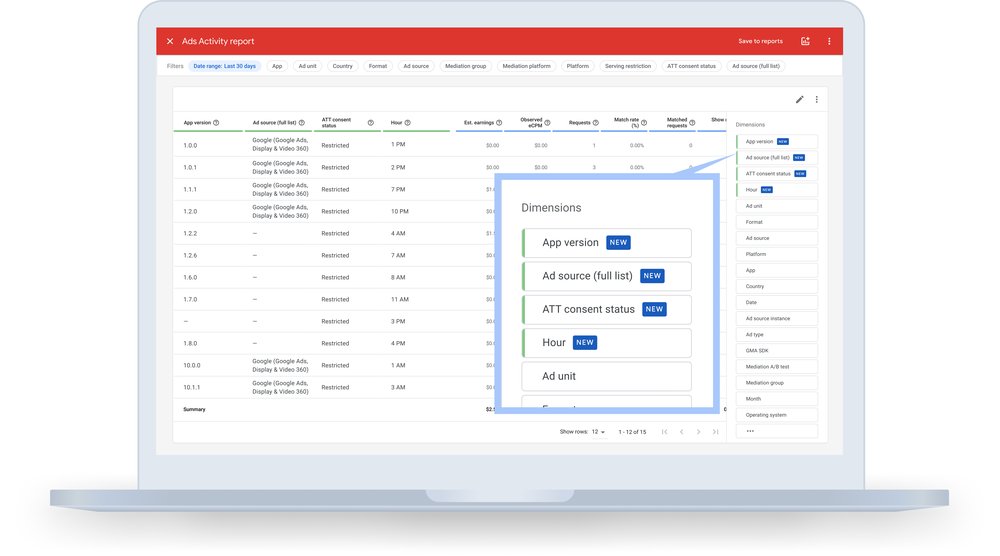With more than 3 billion people playing games across platforms, the games industry continues to evolve rapidly. Still, one thing remains unchanged: developers need to grow revenue and profitability from their mobile games for long term success. This week, at the Think with Google Gaming Day in China, we shared new ways to help developers like you earn more revenue and attract high-value players.
Strengthen your monetization strategies
The right metrics can make a huge difference to your game’s success by enhancing transparency and clarity in your ads performance. AdMob’s updated Ads Activity report contains new measurement dimensions to help you do just that. Easily analyze earnings including those from third-party ad sources with dimensions like “hour of delivery,” “app version” or “ad source.” Publishers can also better monitor and understand the impact of privacy changes on revenue with report dimensions indicating publisher and user response to the iOS privacy framework.

The Ads Activity report contains new dimensions to help you understand your ads performance
Along with the Ads Activity report, we announced more features to help you diversify and grow your revenue for the long-term:
- Google Mobile Ads Software Developer Kit (GMA SDK): Implement the latest GMA SDK version to stay updated on new feature releases such as the same app key that delivers more relevant and personalized ads for your apps on iOS.
- H5 Games Ads (beta): Grow your earnings by easily showing interstitial and rewarded ads in your HTML5 (H5) games today.
- New bidding partner: Access demand from Pangle, now available on AdMob in addition to more than 200 demand partners competing in real-time for your inventory.
Drive deeper engagement and revenue performance
To drive sustainable growth for your game, you’ll need more than just a strong monetization strategy. It is also important to have the right tools to effectively attract quality players. Now, with the ability to add an audience signal to your Android App campaigns, we’re making this even easier. You’ll be able to use your existing knowledge on the types of players you believe your campaigns would be most successful with to help guide our models to find similar new players who are more likely to convert. This will be available in beta in the coming months.
Add an audience signal to help you find new players who are more likely to convert
As the industry moves away from individual identifiers like device IDs, measuring your campaign performance accurately — along with acting on your conversion data — is critical. That’s why earlier this year, we introduced on-device conversion measurement. With on-device conversion measurement, user interactions with app ads can be matched to app conversions in a way that prevents user-identifying information from leaving a user's device. This helps you to prioritize privacy standards without compromising performance. Explore our developer guide to learn how you can implement this solution for your iOS App campaigns.
We are also releasing other new features to help you grow engagement and performance:
- New audience lists: Re-engage high-value players with automatically generated lists of past purchasers based on your apps’ play data. This feature is now generally available through App campaigns for engagement.
- Creative testing for video: Easily run experiments to understand the impact your video creative has on your App campaign performance. This will be available in beta in the coming months.
- Target return on ad spend (tROAS) for ad revenue: Acquire players who are more likely to engage with ads shown in-app. In the coming months, all developers can send ad revenue from monetization platforms to Google Analytics to improve tROAS bidding in Google Ads.
Scale your reach to third-party app inventory
Lastly, advertisers now have the opportunity to extend their App campaign reach to more users. Advertisers using Google Ads and Display & Video 360 will have the opportunity to participate in real-time bidding integrations with third-party monetization platforms AppLovin (MAX), DT FairBid and Helium by Chartboost.
Also, developers who use third-party platforms will now have easy access to competitive real-time bids from advertisers using Google Ads and Display & Video 360. The program is currently in closed beta and these buying tools will be available as a bidder for approved publishers on these third-party real-time bidding monetization platforms at this time.
Watch the full Ads keynote to hear more about how these solutions can help you drive revenue and profitability for your games business.





